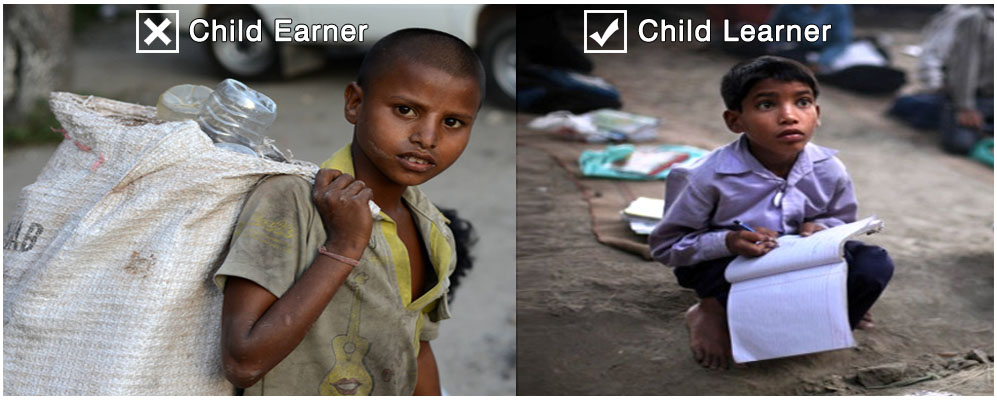According to figures published by CRY- Child Rights and You, close to 1.4 million child labourers in India in the age group of 7-14 years cannot write their names. The analysis of Census data by CRY reveals that one in three child labourers in the said age group are illiterate. This is the grim reality of children who work for more than six months in a year. “Even for children who support the family economy by working for less than six months in a year, which is very common in a country like India, the situation is equally, if not more, worse. A shocking 2 million of these marginal workers have compromised their education as well,” a statement from CRY read. The situation is also reflected in the state figures mentioned in the report. While 45% of child labourers in Bihar are illiterate, in Rajasthan and Jharkhand the figure stands at 40%. Madhya Pradesh and Andhra Pradesh also have about 38% child labourers as illiterate. Komal Ganotra, Director, Policy and Advocacy of CRY said, “Working children and those working long stretches before and after school hours have issues of inattentiveness and tiredness in school, lesser attendance, lack of play time and social bonding after school which subsequently leads to drop out and hampers their growth and development. It is absolutely disheartening to see a 37% increase in child labourers in the category of 5-9 years in the last ten years. In tender years where they should be learning to hold a pencil, they are compelled to take up the burden of playing economic roles.” These staggering numbers show the probable dark future of about 1.4 million child labourers in India who may have to struggle with unstable employment when they grow up. “These children when they grow remain at a risk of not having secured jobs and thus remain trapped in the intergenerational cycle of poverty and deprivation. We are approaching 6th Anniversary of Right to Free and Compulsory Education and it is crucial that state reviews its strategies in order to reverse this trend,” the statement further read. Opposing the legal framework concerned with child labour, the report said, “India’s legal framework is based on the assumption that children can work and still be educated. The numbers stated earlier blatantly contradict this assumption and are evidence enough that this needs to change, for main as well as marginal child labourers. In 1992 when India ratified the United Nations Convention on the Rights of the Child (UNCRC), a reservation was made in article 32, wherein the Government of India articulated that it would progressively ban all forms of child labour. Now, after 30 years since the Child Labour Law came into force, India has the opportunity to amend the law in favour of its children.” The proposed amendment in the Child Labour law leaves a glaring gap in the prohibition of labour for children under the age of 14. The new law also allows children in this age group to work in family occupations after school hours, CRY stated. The Census 2011 data for children in labour, stated that 6.5 million children in India in the age group of 5 to 14 years work in agriculture and household industries. This makes a staggering 64.1% of child labourers in this age group. CRY’s on ground experience revealed that a large number of children engaged in these occupations are working with their families, thus exempting them from the proposed ban. According to CRY, allowing children to work in family enterprises is likely to have far reaching implications affecting not only their education and learning outcomes but also their health and overall development. “Given our current structures of education and labour department and the existing social fabric, it is a matter of great concern to monitor children juggling economic roles while assisting in family employment post-school. This will go against the spirit of Right to Education which needs to be viewed as an equal opportunity to study and learn rather than just mandated hours of schooling. For the learning outcomes to improve our children thus needs to be exclusively in school and learning,” Ganatra added. The report calls for analysing of our policies and actions under Right To Education and child labour laws. To ensure poverty-free and future of these kids, it is imperative to impart education to them. Businesses too can play their roles well by pledging no child labour in their organisation and efforts to educate and empower children for growth. Nobel Laureate Kailash Satyarthi’s on World Child Labour Day advised business houses to work for the eradication of child labour. “The role of the business has to evolve, and it is time we rose above our traditional and conventional thinking in these linkages since a minute late is a minute too late. As we mark June 12 as the World Day Against Child Labour, let us pledge to prioritise and protect those most-affected and deprived of their childhoods,” he said.
Thank you for reading the story until the very end. We appreciate the time you have given us. In addition, your thoughts and inputs will genuinely make a difference to us. Please do drop in a line and help us do better.
Regards,
The CSR Journal Team


